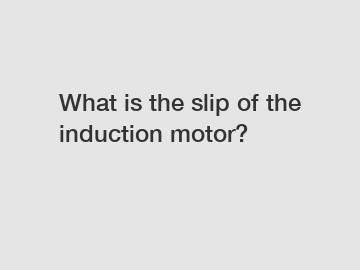What is the slip of the induction motor?
Induction motors are widely used in various industrial and commercial applications due to their reliability and efficiency. One important parameter that is often discussed in relation to induction motors is the slip. The slip of an induction motor is a crucial factor that affects its performance and efficiency. In this article, we will explore what the slip of an induction motor is, how it is calculated, and why it is important in motor operation.
### Understanding Slip.
The slip of an induction motor is defined as the difference between the synchronous speed of the motor and the actual speed of the rotor. In simpler terms, it is the speed at which the rotor turns slower than the stator's magnetic field. The slip is expressed as a percentage of the synchronous speed, which is the speed at which the rotating magnetic field of the stator rotates.

### Calculating Slip.
The slip of an induction motor can be calculated using the formula:
Slip (%) = [(Ns - Nr) / Ns] x 100.
Where:
- Slip (%) is the slip expressed as a percentage.
- Ns is the synchronous speed of the motor in revolutions per minute (RPM).
- Nr is the actual speed of the rotor in revolutions per minute (RPM).
For example, if the synchronous speed of a motor is 1800 RPM and the actual speed of the rotor is 1750 RPM, the slip can be calculated as follows:
Slip (%) = [(1800 - 1750) / 1800] x 100 = 2.78%.
This means that the motor has a slip of 2.78%, indicating that the rotor is turning 2.78% slower than the synchronous speed of the motor.
### Importance of Slip.
The slip of an induction motor is a critical parameter that directly affects its torque, efficiency, and power consumption. A higher slip generally indicates that the motor is operating under heavier load conditions, resulting in higher torque output. On the other hand, a lower slip implies that the motor is running closer to its synchronous speed, which may be more efficient but may not provide as much torque.
In practical applications, the slip of an induction motor is carefully monitored and controlled to ensure optimal performance. Motors with adjustable speed drives, such as variable frequency drives (VFDs), can dynamically adjust the speed of the motor to maintain the desired slip for specific operating conditions.
### Conclusion.
In conclusion, the slip of an induction motor is a crucial parameter that reflects the difference between the synchronous speed of the motor and the actual speed of the rotor. By understanding and controlling the slip, motor manufacturers and operators can optimize the performance, efficiency, and torque output of the motor for specific applications. Monitoring the slip of an induction motor is essential for ensuring reliable and efficient operation in various industrial and commercial settings.
For more information on induction motors and their slip, feel free to contact us.
The company is the world’s best Types of Induction Motors, Wound Rotor Vs Squirrel Cage, Asynchronous Motor 3 Phase supplier. We are your one-stop shop for all needs. Our staff are highly-specialized and will help you find the product you need.


